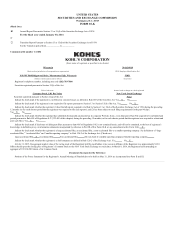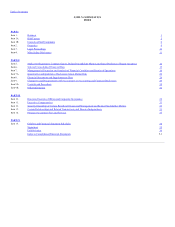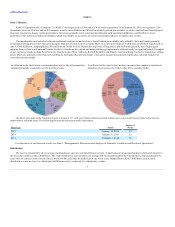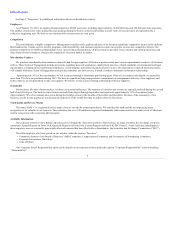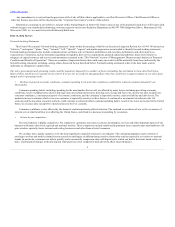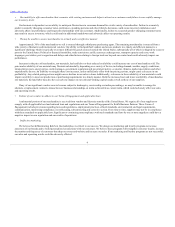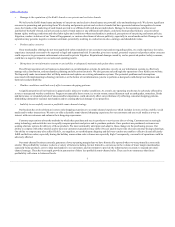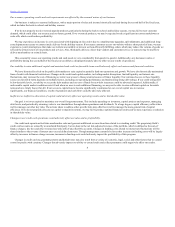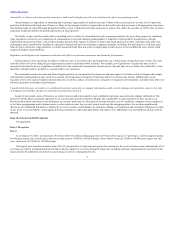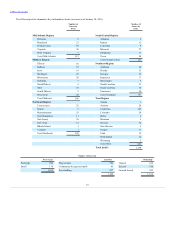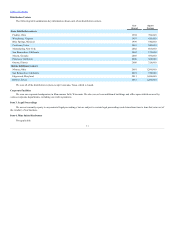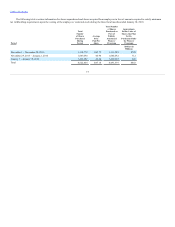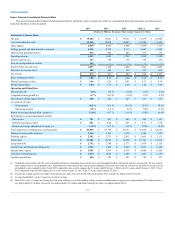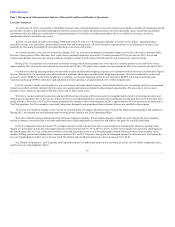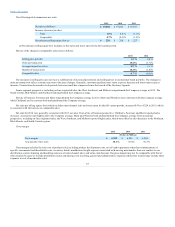Kohl's 2015 Annual Report Download - page 8
Download and view the complete annual report
Please find page 8 of the 2015 Kohl's annual report below. You can navigate through the pages in the report by either clicking on the pages listed below, or by using the keyword search tool below to find specific information within the annual report.
Table of Contents
Our revenues, operating results and cash requirements are affected by the seasonal nature of our business.
Our business is subject to seasonal influences, with a major portion of sales and income historically realized during the second half of the fiscal year,
which includes the back-to-school and holiday seasons.
If we do not properly stock or restock popular products, particularly during the back-to-school and holiday seasons, we may fail to meet customer
demand, which could affect our revenue and our future growth. If we overstock products, we may be required to take significant inventory markdowns or
write-offs, which could reduce profitability.
We may experience an increase in costs associated with shipping on-line orders due to complimentary upgrades, split shipments, and additional long-
zone shipments necessary to ensure timely delivery for the holiday season. If too many customers access our website within a short period of time, we may
experience system interruptions that make our website unavailable or prevent us from efficiently fulfilling orders, which may reduce the volume of goods we
sell and the attractiveness of our products and services. Also, third-party delivery, direct ship vendors and customer service co-sourcers may be unable to
deliver merchandise on a timely basis.
This seasonality causes our operating results and cash needs to vary considerably from quarter to quarter. Additionally, any decrease in sales or
profitability during the second half of the fiscal year could have a disproportionately adverse effect on our results of operations.
Our inability to raise additional capital and maintain bank credit on favorable terms could adversely affect our business and financial condition.
We have historically relied on the public debt markets to raise capital to partially fund our operations and growth. We have also historically maintained
lines of credit with financial institutions. Changes in the credit and capital markets, including market disruptions, limited liquidity and interest rate
fluctuations, may increase the cost of financing or restrict our access to these potential sources of future liquidity. Our continued access to these liquidity
sources on favorable terms depends on multiple factors, including our operating performance and maintaining strong debt ratings. If our credit ratings fall
below desirable levels, our ability to access the debt markets and our cost of funds for new debt issuances could be adversely impacted. Additionally, if
unfavorable capital market conditions exist if and when we were to seek additional financing, we may not be able to raise sufficient capital on favorable
terms and on a timely basis (if at all). If our access to capital was to become significantly constrained or our cost of capital was to increase
significantly, our financial condition, results of operations and cash flows could be adversely affected.
Inefficient or ineffective allocation of capital could adversely affect our operating results and/or shareholder value.
Our goal is to invest capital to maximize our overall long-term returns. This includes spending on inventory, capital projects and expenses, managing
debt levels, and periodically returning value to our shareholders through share repurchases and dividends. To a large degree, capital efficiency reflects how
well we manage our other key risks. The actions taken to address other specific risks may affect how well we manage the more general risk of capital
efficiency. If we do not properly allocate our capital to maximize returns, we may fail to produce optimal financial results and we may experience a reduction
in shareholder value.
Changes in our credit card operations could adversely affect our sales and/or profitability.
Our credit card operations facilitate merchandise sales and generate additional revenue from fees related to extending credit. The proprietary Kohl's
credit card accounts are owned by an unrelated third-party, but we share in the net risk-adjusted revenue of the portfolio, which is defined as the sum of
finance charges, late fees and other revenue less write-offs of uncollectible accounts. Changes in funding costs related to interest rate fluctuations will be
shared similar to the revenue if interest rates exceed defined amounts. Though management currently believes that increases in funding costs will be largely
offset by increases in finance charge revenue, increases in funding costs could adversely impact the profitability of this program.
Changes in credit card use, payment patterns and default rates may also result from a variety of economic, legal, social and other factors that we cannot
control or predict with certainty. Changes that adversely impact our ability to extend credit and collect payments could negatively affect our results.
8

